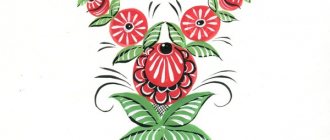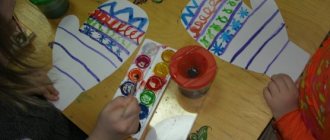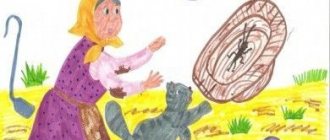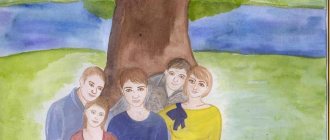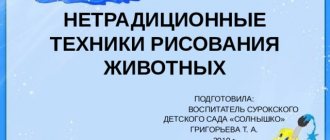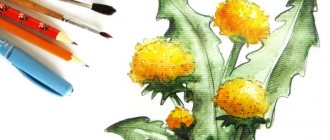Lesson “Colors of Khokhloma painting. Gouache"
- March 11, 2018
International and All-Russian competitions
All-Russian competition of pedagogical excellence “Methodological treasure chest of a teacher of additional education”
This lesson is conducted according to the additional general education general developmental program of artistic orientation “Young Artists” (author-compiler: teacher of additional education of the 1st quarter category Nikolaeva E. O.; implementation period 4 years; age of students 7-15 years) for students of the first year of study ( 7 years).
Every year, a group of first-graders is formed in our creative association “Young Artist”. And classes with them are always the most difficult and responsible for me. How to get kids involved? How to show them that drawing is an amazing, magical world where you can and should fantasize, try new and interesting things.
And so a whole set of activities was born - fairy tales, with the help of which I introduce my first-graders to the fine arts. And the children gladly accepted this and joined the game!
The lesson “Colors of Khokhloma painting” is held in the middle of the school year, when students have already become more familiar with the world of fine arts, know and are able to use brushes and work with paints. During this lesson, first-graders become familiar with the history of Khokhloma painting and its color scheme.
Topic of the lesson: “Colors of Khokhloma painting. Gouache"
Purpose: to introduce the color scheme of Khokhloma painting.
Tasks:
Educational: develop imagination, artistic taste, color rhythm.
Educators: cultivate interest in folk crafts.
Educational:
- introduce the history of the emergence of Khokhloma painting.
- teach children to use characteristic colors for Khokhloma painting.
Type of lesson: studying primary knowledge and consolidating new knowledge.
Teaching methods: informational, practical, problem-based, game-based.
- computer, presentation “Khokhloma painting, like witchcraft”, stencils for coloring, brushes, gouache.
Venue: d/k Avtomobilist.
Age of students: 7-8 years.
Lesson plan:
- Organizational moment (1 min).
- Creating a problem situation (2 min).
- Setting the topic and purpose of the lesson (3 min).
- Main part (27 min).
- Presentation “Khokhloma painting, like witchcraft” (5 min).
- Physical exercise (2 min).
- Practical work (20 min).
- Summarizing. Assessment of students' activities (5 min).
- Reflection (2 min).
Progress of the lesson
Organizing time
Teacher: Has everyone taken their seats? Is anyone cramped? I'll tell you a secret: It will be interesting!
Let's check more carefully
So that we don't waste time later.
Gouache, napkin, brushes and a jar of water -
That's all we need with us today.
Creating a problem situation
Teacher: Oh, guys, Prince Pencil and Princess Brush continue to travel around our country, and today they sent us a letter and a parcel, let's see what's there (show a black and white plaque with Khokhloma painting).
Teacher: Look, what is it? What's happened? I think this is not at all what Brush and Pencil wanted to show us. How do you think? What happened? Again the pranks of the Blob (usually the children themselves begin to say that only the Blob could misbehave). So what should we do? How can such a parcel be shown in the Kingdom now? (Children offer solutions).
Setting the topic and purpose of the lesson
Teacher: Yes, you’re right, let’s fix everything, draw it the way it should be. And who knows how it should be? What is this interesting drawing? Let's look at the email from Pencil Brush.
(Slide show).
Teacher: Why do you think they call it that, witchcraft? Have you already guessed what we will do in class today? So, the goal of our lesson today... is to paint the board with Khokhloma painting.
But before you draw, you need to get to know this miracle better.
Communicating new knowledge.
(Slide 4).
Teacher: They say that a long time ago a cheerful craftsman settled beyond the Volga. He built a hut, built a table and a spoon, and carved wooden dishes. I cooked millet porridge for myself and did not forget to sprinkle millet for the birds. One day a firebird flew to his doorstep. He treated her too. And suddenly the firebird touched the cup with its wings, and the cup became golden.
This is, of course, a fairy tale, but maybe not a fairy tale. No one knows. But here is what is really known about Khokhloma.
(Slide 6).
Teacher: The painting of dishes was done by peasants who lived in villages located around the village of Khokhloma: Novopokrovskoye, Semino, Khryashi and Kuligino.
The production of such utensils became especially widespread 200 years ago. Khokhloma products were distributed throughout Russia through the Nizhny Novgorod Fair and exported to the countries of Asia and Western Europe. They attracted attention with their original coloring and beautiful varnishing.
Let's see, what is the originality of Khokhloma painting? (Festive colors, beauty of ornament). At the same time, the products were cheap and durable to use: the varnish covering them was so good that it could withstand high temperatures. The dishes did not change color due to hot food and did not lose their beautiful painting.
Take a closer look at this painting and tell me what colors are used? (Please emphasize that there are only 3 colors). What elements does it consist of? Let's take a closer look at them. (slide).
What tools are needed for painting? (brushes, paints, “frogs” - a ball of wool or foam rubber) (slide).
The art of Khokhloma has spread not only to household items, dishes, furniture, but also delights us simply in the most unusual places. Judge for yourself! (slide).
Beautiful painting? Like? Well, let's try to return all the colors to their place. But before we start drawing, let's warm up a little.
Physical exercise “Fun exercise”
Practical work
Teacher: And now it’s time to dispel the evil spell of the harmful Blot. I will help you with this. To make our drawings bright and neat, I suggest doing finger exercises.
Guys, let's remember how to work with brushes correctly. And most importantly, guys, in order for our lines to turn out thin and smooth, like those of real masters, watch how you place the brush on the paper. Be sure to place it only vertically, touching the paper with the very tip. When drawing, try not to let go of your hands and draw a line continuously, imagine that your brush is “dancing” across the paper, sliding smoothly and softly. Then you will succeed!
TB instruction.
Great! So, 1-2-3-4-5, let's start drawing!
Hands? - On the spot! Legs? - On the spot! Elbows? - At the edge! Back? - Direct!
Practical work, individual assistance (children color the prepared sketch).
Summarizing. Analysis of works.
All works are hung on a board under numbers. The black and white image of the board with painting changes to color.
Teacher: Look, guys! Blob got scared! The colors have returned to us! What a great fellow you are! Real masters and wizards!
Evaluation of work by students. The most successful moments in each work are highlighted.
Teacher: What painting did we meet today? Why was she called that? How is it different from others: Dymkovo or Gzhel?
Reflection
Teacher: Let's now try to express in colors everything that we feel now.
"Traffic Light" technique. Red - everything is bad, nothing worked out, nothing was pleasant, green - everything is good, interesting, everything worked out, yellow - something worked out, something didn’t, not very interesting.
Teacher: Well done! You did a good job! In the next lessons we will continue our acquaintance with the wonderful world of Khokhloma painting and learn how to draw its elements. See you!
Presentation “Khokhloma painting, like witchcraft”
Materials for painting and stages of preparation for painting
Wooden bases for painting are called “linen”. To make objects from wood, you need not only paint of different shades, but also special purified clay (wapa), which acts as a primer. Drying oil (linseed oil) is also necessary, the correct application of which determines the strength of the pattern.
The next stage is called tinning, which is performed with aluminum powder. It is intensively rubbed into the product, after which the objects acquire shine and are ready for further painting. The paints that the masters use in their work are only oil paints, and the brushes for applying the pattern are mainly squirrel paints.
Varieties of Khokhloma
There are several types of painting in the Khokhloma style. They differ in the method of application and image on wooden objects. Based on the type of application, Khokhloma is divided into the following types:
- background - the design is made on a plain main background, and the ornament is made with gold paint;
- upper – applying a pattern to a ready-made field.
The technique has various painting methods. The most complex technique is applying painting under the background. Initially, the contours of the pattern are applied to the wooden blank, and then some parts begin to be painted over with a black or red background color. After applying the background layer, they begin to make patterns and other complex details.
"Gingerbread"
The simplest method is called “Gingerbread”. In the center of the product there is an image of a geometric figure, for example, a rhombus or a square. Inside it is supplemented with sun, climbing plants, and herbs.
"Grass"
“Travka”, or herbal painting, is applied in abrupt strokes. Leaves are painted with large strokes, blades of grass or dew drops are used with smaller strokes. This element of top painting allows you to fill the entire surface of the product with an openwork pattern. This is one of the most difficult types, which requires patience and special attention from the master.
"Berry"
Another technique called “Berry” is very reminiscent of “Grass”. However, the style looks richer and more decorative than the previous one. It is based on an interweaving of large berries and herbs. As a rule, masters depict strawberries, gooseberries, grapes, and among flowers - chamomile and bell.
"Kudrins"
“Kudrina” is characterized by a certain ornate floral pattern. In this case, the ornament is made with gold paint. The peculiarity of application is to work with a very thin brush.
How and when did Khokhloma originate?
Archives show that beautiful painted dishes were first mentioned in 1659. It was then that a certain boyar named Morozov demanded to collect dishes of various sizes and tin craftsmen from the Trans-Volga lands. In those days, tin was used for gilding. Morozov at that time owned the village of Semenovskoye. In it, as well as in a neighboring village called Khokhloma, a craft for painting wooden products was formed.
The development of such a trade in Rus' was facilitated by the proximity of a large trade route (Volga) and the proximity to the fair - Makaryevskaya. The quality of the dishes was so high that their production was made the main industry for the residents, and the village of Khokhloma became a trading point where unique dishes with unusual designs were sold. After 1916, it was decided to open the School of Artistic Processing of Wooden Products. So Khokhloma received a new round of development.
